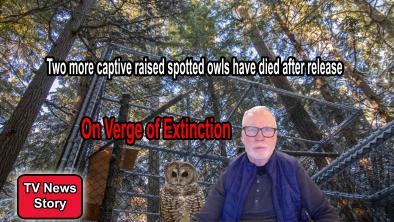Wild Times: Canada's Last Wild Spotted Owls
Watershed Sentinel

BC's Fraser Canyon is a truly awesome landscape. Here the Fraser River boils, rolls and froths as it muscles its way through the Coast and Cascade mountains. Down by the great river, layer upon layer of human history is stacked side by side.
A cluster of ancient Nlaka'pamux pit house depressions in a riverside forest are a reminder this place has been a sacred home since time immemorial. Wooden drying racks on stone outcrops are a testament to Indigenous salmon fishing and drying that has gone on for untold centuries right up until today. Metres away from the pit house and fish rack sites are remnants of the old Cariboo road to the goldfields of the 1860s. A train blasts its horn and a raven takes flight as the sound reverberates off the sheer cliffs towering above the rail tracks and the paved lanes of Highway I.
Now there's something else of note in the canyon. This is the last stand of the spotted owl in the Canadian wild.
Once numbering about 500 pairs in the old-growth forests of BCs southwest mainland, the owls' numbers have plummeted since the gold rush and then industrial logging. And the industry continues to devour the last of the old-growth forests to this day.
At one time not that long ago, spotted owls could be found throughout their range in Canada from Lillooet to the US border and from western Manning Park to the coast. Now the last surviving wild spotted owls barely hang on in the Fraser Canyon region.
These days the majority of Canada's spotted owls are not wild at all. They are cooped up in a captive breeding facility set up by the province of BC in Langley. The hope is that after a decade of slowly increasing baby owl numbers, government biologists can begin releasing some of the young captive-bred owls into the wild in the next year. The goal is to eventually return the population to a healthy number of 250 owls in the wild.

A recent trip to visit the canyon hideout of Canada's last wild spotted owls was a sobering revelation. I ran smack dab into clearcut logging, mowing down habitat in this precious last refuge. Even worse — the logging was planned by the government's own operation, BC Timber Sales.


The BC government, instead of being the salvation of this endangered species, is, in fact, the chief architect of its extinction in the wild in Canada. What good is producing baby owls when logging companies are still permitted to log their dwindling habitat? That's why we at the Wilderness Committee, represented by Ecojustice, have recently demanded Canada's environment minister produce an action plan to save the spotted owl, and that a federal order be issued to BC to cease and desist from permitting logging in the spotted owl's forest habitat.
The BC government's decades-long love affair with the logging industry hasn't just hit the owl hard. There are now well over 1,600 wild plants and animals on the provincial species-at-risk list.
Seeing the fallen forests of the Fraser Canyon hit me like a punch in the gut. It was a clear sign of what this provincial government really thinks about Canada's last wId spotted owls — not much. It's time for the federal minister to take over and save what remains of the old-growth forests before the spotted owl and the other, wildlife that lives with it, fade away.
Read Joe Foy's Wild Times column in the Watershed Sentinel, as he explores the last area where Canada's wild spotted owls still live.


